Linz
The Synthetic Site Folder and Site Brief are available for free.
Please register and login to access the Complete Site Folder.
- Synthetic site folder EN
- Site on Google Maps
- Back to map
Data
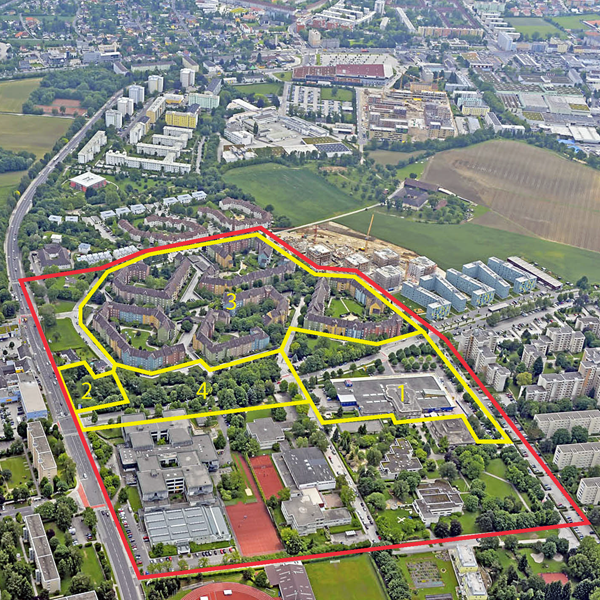
Category Urban - architectural
Location Linz, Österreich
Population 198,500 inhab.
Strategic site 19 ha - Project site 1: 2.4 ha / 2: 0.3 ha / 3: 6.7 ha / 4: 1.2 ha
Site proposed by WAG & City of Linz
Owner(s) of the site WAG Wohnungsanlagen Ges.m.b.H.
Commision after competition Urban project management role, design of public and landscape areas, further involvement in architectural follow-up procedures
Team representative architect - urban planner - landscape architect
More Information
How can the site contribute to the adaptable city?
A strategic masterplan shall initiate a transformation process of the urban core of a large residential complex, addressing revitalization of public spaces, densification through infills and transformation of existing buildings: an outdated shopping mall shall be replaced and become the new center: a mixed use center-building-complex (shoppingmall with living) with a transformation of the adjacent public spaces; A new “entrée-building” at the corner to the main street shall trigger attention to the renewed neighbourhood center; The in-between spaces of the neighbouring 1980s development shall be adapted trough punctual interventions; Car-parking in general has to be reconsidered; The central alleyway (Europastraße) shall be adapted to a vivid public strip, remodelling the landscape and organizing the traffic.
City strategy
The traditionally industrial city aims at strengthening its profile as innovative town in the productive and cultural sectors. In addition to the implementation of large infrastructural projects the gradual conversion of the industrial heritage is of main concern for the city development: large scale industrial areas such as the harbour and the tobacco factory (Europan 11) are under heavy transformation. Another main concern is the great heritage of subsidized housing which was developed to a large extend for the workers in accordance with the industrial growth. In order to integrate these housing complexes in the development of the contemporary city a process of adaptation has been ongoing since years, addressing issues of ageing, lifestyles, abandoned in-between spaces and social polarization.
Site definition
The residential area is located in the South of Linz and forms a large socially mixed neighbourhood which has been developing since the last 50 years: the ideals of social housing have left the traces of their typological and atmospherically heritage: like in a housing zoo one can experience the 1960s, 70s, 80s and more recent housing developments of the last years. Whereas the physical extension has reached its limits, public space and urban life are suffering from a lack of quality. Especially around the central area, the Europastraße between the entrance point at Landwiedstraße and the existing shopping mall which was ´face-lifted´ in the 1990s: green dams against noise, terraced parking spaces with private gardens as well as the still introverted mall prevent the development of possible activities in the abundantly available open in-between spaces.
Future of the site in relation to the site family and to Adaptability
The result of the EUROPAN13 competition shall provide a strategic urban masterplan which transforms the adjacent in-between spaces of the residential area (Ps3) through punctual interventions and improves existing qualities in the central public area of Europastraße (Ps4) connecting the focused two poles: the new mixed used center-building-complex with attractive public space (Ps1) and the entrée-building-typology to trigger attention and urbanizes the corner (Ps2).
Buildings As Intensifiers Of Local Activities – Adding new infills: Replacing the existing mall by a mixed use center-buildingcomplex which generates community-life and attracts activities. Developing a typology as an entrée-building to the residential area.
Mobility As A Revitalizing Device – Reorganizing parking, improving pedestrian and bike mobility, addressing the quality of ´the way home´, transforming the access to existing buildings, connecting to the surrounding.
Landscaping As A Tool To Create Places To Stay – Addressing the quality of surfaces, reflecting public-furniture, creating transitions between public and private areas, sharing public space.
Agency For Neighbourhood Initiatives – Creating incentives and participative strategies to reoccupy the new environment and transforming under the premises of the masterplan.
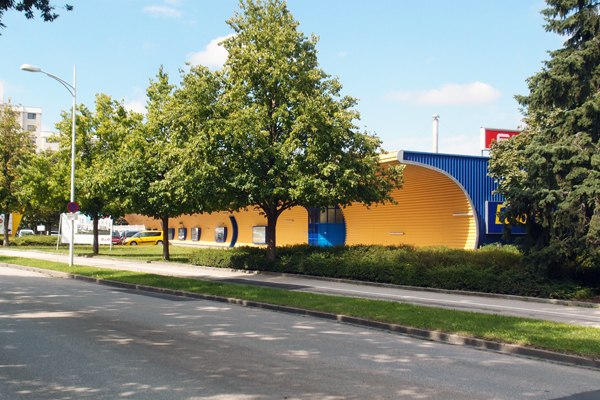
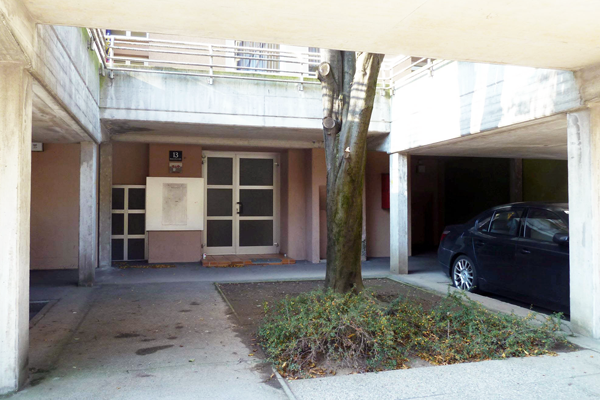
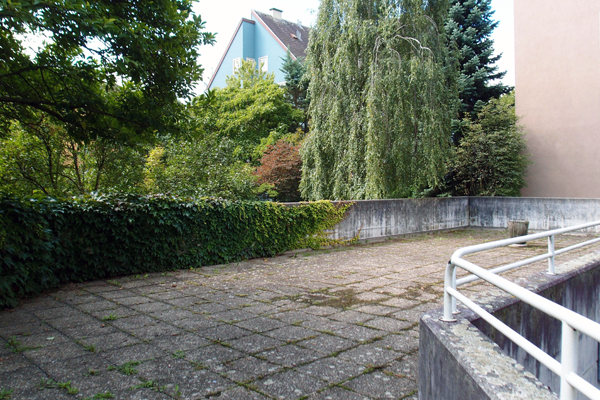
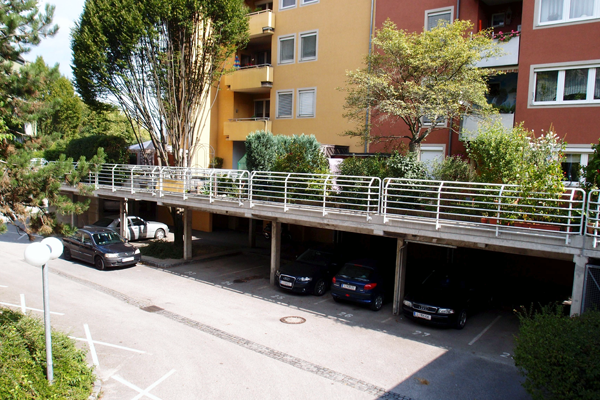
Questions on the site
Is it possible to have a report of the site visit? and a copy of the power point-presenation shown? thank you.
The report of the site visit is online and the presentation of WAG of the site visit is uploaded.
Is it possible to provide a digital plan drawing of the layout and entrance ramp of the existing parking garage under the SPAR on site 1?
No, digital plans of the existing underground parking garage on project site 1 cannot be provided.
Due to constructional regulations it is recommended to propose a new underground parking garage. Therefore it is not possible to reuse the current underground parking garage below the current shopping mall.
Is it possible to provide a scematic plan drawing showing the total overall layout and numbers of the existing car parking facilities on the entire site (site 1-2-3 and 4)? -Thankyou.
Yes, the document will be uploaded very soon.
In site 2, all parking housing must be located in ground floor level? Would be acceptable underground parking?
In site 2, there is no rule where the parking should be located. In general the parking can be located underground and above level - depending on the proposed typological concept.
The map file LINZ-AT-PS-M10.dxf cannot be imported into our CAD software, it gives an error message ‘xrefs not found in master file, unable to import’. Please could you upload it again.
The file is damaged and deleted now. The file LINZ-AT-PS-M13-dwg was uploaded on 30th of April and has the same content like the damaged dxf-file, just saved as dwg.
Please provide traffic data for Europastrasse if available.
Europastraße: average vehicle traffic per day: 7.500 - 8.500
As written in the brief p.17: "Europastraße is the main access street to the neighbourhood and is also used by one bus-line (busstop in project site 1 in front of the shoppingmall). Existing turning lanes at the crossing Europastraße/Landwiedstraße are necessary to regulate the traffic flow at the crossing and cannot be removed. Therefore it is impossible to close or minimize Europastraße for vehicle traffic! Nevertheless concepts of an improved articulation of the street space of Europastraße to a can be tested and proposed. Especially concerning the integration of the urban center square on project site 1. It is strongly recommended to collaborate with good traffic planners."
Please confirm how far away from dwellings it is acceptable to provide parking within the proposed development (and re-development of the existing housing).
Site visit report: "In general in Linz approx. 70% of the people want to park their car ´in front of their entry´."
- Project site1: "Due to constructional regulations it is recommended to suggest a new underground parking garage" - the current underground parking garage cannot be reused. The position of the access to the underground parking garage has to be reflected.
- Project site 2: It is up to the teams to propose an underground parking garage or not. Nevertheless it is necessary to provide the required parking lots. Vehicle access is only possible from Albert-Schöpf-Strasse.
- Project site 3: "The current parking situation of 624 numbered parking lots of WAG (1 lot per apartment) on the parking level (below the gardens) and in the underground parking garage has to be accepted. It is not possible to reorganise them and collect them somewhere in a collective parking garage as the inhabitants would not accept a change of their habit. The additional new 100 parking lots for the attic-extension of WAG in Albert Schöpf Siedlung could be collected in a collective parking area (e.g: on the dam strip on project site 4)" Nevertheless the parking structure should add value as an urban element and not operate as a monofunctional parking garage (e.g: usage of parts of the ground floor area or usage of the roof).
A diagram of currently distributed parking lots will be uploaded very soon.
Does WAG have any established policy / preference about how parking should be provided within new developments (e.g. basement / surface / other)?
There is no official policy. See site visit report: project site 3.
Underground parking for project 1 and 2 can be considered.
100 new parking lots for the attic-extension in Albert Schöpf Siedlung can be collected as an above-parking-structure on the dam strip in project site 4. Nevertheless the parking structure should add value as an urban element and not operate as a monofunctional parking garage (e.g. usage of parts of the ground floor area or usage of the roof)
Are all 'gastronomy and shops' individually operated units? Are there any preferred dimensions, e.g. clear storey height, width, depth
The clear room height of these shops should be 3,5m clearance (see site visit report).
The different sizes of the different shops are described in the competition brief p. 18 / Urban ground floor.
There is no defined information about width and depth provided.
All shops can be seen as individually operated units.
They all are tenants of WAG and therefore they are neighbours sharing the space and being part of the urban program.
For project site 1, should the parking for housing and Eurospar be kept separate?
No, they can share one underground parking garage. Parking lots for housing will be numbered and should not be directly mixed with the parking lots of the Eurospar.
For project site 1, does underground have to be located below grade (i.e. basement level) or simply covered parking (i.e. could be at ground floor level)?
It is necessary to provide the required number of underground and above car and bike parking. The current underground parking garage cannot be reused, it is recommended to propose a new underground parking garage.
To create an urban center square of high quality, the parking on groundlevel has to be reflected and positioned carefully.
Is it permissible to build on the southern side of Europastrasse in Project Site 1?
brief p.17: In general it would be possible to overbuild Europastraße if it is necessary for the concept. Nevertheless the streetspace has to stay public.
site visit report: Implementing a physical bridge-building over Europastraße does not make sense as it would create high costs and influence the public space strongly.
Therefore it is recommended not to overbuild Europastraße.
DISTANCE FROM PLOT BOUNDARIES – Please clarify whether buildings may be placed on plot boundaries facing roads and public spaces. The wording of document ‘LINZ-AT-PS-M12’ is unclear.
Buildings facing public streets and public places: the required minimum distance to plot borders does not need to be kept. Yes, buildings can be placed along plot boundaries facing public streets and public places. An updated version of the document about building regulation will be uploaded very soon.
FIRE ESCAPE FROM RESIDENTIAL BUILDINGS – Can you please provide basic explanation / guidance on how many stairs are needed in highrise residential buildings in Austria
For buildings with the last floor level higher than 22 meters above the adjacent ground, special building restrictions apply (higher requirements of escape ways - such as compressed aeration, higher requiremetns for facades, etc).
These requirements increase the building costs.
Therefore heights above 22m floor level (25m building height) should be avoided, except for having good reasons.
In no case the building can be higher than 35m (=highest floor level: 32m above adjacent ground) = high-rise-building.
It is clearly recommended to avoid high-rise-development (on all sites).
Required escape route = maximum 40m from each entry of apartment to the staircase.
If the route is longer than 40m, a second staircase is needed. If the building height is higher than 35m (high-rise!), an additional staircase is anyhow required (even if the 40m escape route of each apartment is provided.)
n document LINZ-AT-PS-M15 400 sq.m is required for Doctor’s Practice, this requirement does not appear within the competition brief however. Please confirm whether this is an additional requirement. Does this require additional parking provision?
Yes, this is an additional requirement which was discussed for the first time at the site visit. It is for this reason that it is not written in the competition brief, but then written in the site visit report.
400m2 for doctors practice: According to the rules 1 parking lot is required for 30m2 net surface area of doctors practices.
LEVELS – Is it possible to provide spot level heights through site 3 to help understand the complex relationship between terraces, parking, gardens, etc.
A diagram showing the different levels will be uploaded soon. We cannot guarantee to provide sections.
BUILDING CODES – Do local building regulations require more than one circulation core once a building reaches a certain height or length?
Yes, they do, depending on the escape route and the building height: Required escape route = maximum 40m from each entry of apartment to the staircase.
If the route is longer than 40m, a second staircase is needed. If the building height is higher than 35m (high-rise!), an additional staircase is required (even if the 40m escape route of each apartment is provided).
PARKING – Are the 50 car parking lots for the Health Centre (Site Visit PDF) included within the 100 parking lots listed in the brief for Eurospar, or are they additional to this requirement?
The current 50 above-ground-parking lots of the health center need to be maintained: either to stay where they are or to be reporganised (they need to provide proximity to the health center).
They are NOT included in the brief of 100 parking lots for Eurospar. They have to be considered additional.
EUROSPAR – Does the 15m2 ramp have to be external? If not what clear height is required?
Explanation in the new uploaded document LINZ-AT-PS-M18.pdf
Where I can download the report of the visit?
On the European website: klick on the sitepage of Linz, on the right klick on "site visit", there you can dowload the document.
There is a limit of high of the building to respect?
Brief p.26: It is clearly recommended to avoid skyscraper.
Site minutes report: The mixed use center-building should implement certain verticality, nevertheless it is recommended that the floor level of the highest storey should not be higher than 22m! This limit of height also applies for project site 2.
How does the 7% turnover of tenants compare with averages in Linz and Austria? Is it considered to be high, low, or standard?
According to WAG this percentage is not very high; it can be seen as an approximate standard.
As brief says, the project site 2 is only accessible from albert-schopf-strasse, not from landwiedstrabe. is this talking about current situation or it is a planning regulation for this site? this affirmation is referring for all type of accessibility or only vehicle access?
Vehicle-access to project site 2 is only possible from Albert-Schöpf-Strasse.
It is impossible to implement vehicle-access from Landwiedstrasse - this would disturb the big crossing Landwiedstraße/Europastrasse.
About the project site 3 (pg 24) it is said: “the system of entrance situations has to be reflected and reorganized”. What is exactly the problem in this system of entrance? Is it possible to change deeply the inside architecture of the building’s entrances? In that case, more detailed information about the Housing Rings would be required.
No, the brief asks not to change deeply the inside of the architecture of the entrance situation. As written in the brief as a result of the attic-extension of the neighbourhood, more people will use the entrances (additional 2 attic apartments per housing entrance).
Acupunctural interventions - like reprogramming and concepts of reorganisation (etc) - should improve the spatial atmosphere and the adjacent outside surroundings to make the spaces more attractive and enrich/change their daily usage.
e.g. no garbage directly in front of the entrance, improvement of the courtyard-like entrance-space with the tree at the parking level, when or why do I decide to use the entrance at the "parking-level", why would I use the one at the "pedestrian-level"? What kind of programmatic or spatial intervention could enrich the usage of the entrances on both levels?
Photos of the entrance situations are included in the brief.
Is it possible to open some of the existing private gardens (over the parking lots) to public access? Or should we respect strictly their private realm?
It is recommended to respect the private gardens on the garden level as private outdoor space. Inhabitans would not agree to give up their private gardens.
There are some public terraces located on the garden level: they can/should be used/transformed/improved as part of the strategy.
A diagram showing the levels and distribution of private gardens and public terraces will be uploaded soon.
Is it possible to understand all the project sites as a whole or each one should be seen as an independent plot? Could the entrée-building at project site 2 occupy part of the adjacent plot project site 4?
The overall urban strategy/concept has to consider all four project sites as one whole development area.
The different tasks, programs and conditions of the four sites require an individual process/project for each project site - still being part of the overall strategy.
Project site 2 / Entrée building: It is recommended to respect the plot borders. If you provide a good reason to create an added urban value by not respecting the plot border between ps2 and ps4, you can do so, but you need convincing arguments.
One reason to respect the plot borders is the issue of ownership (and therefore different availability, also in time) : project site 2 belongs to WAG. project site 4 (strip of dam) is half owned by WAG and half owned by an association. (The intention of WAG is to buy the whole strip)
This site is connected to the following theme
How to create positive dynamics from a difficult situation? Many sites are faced with difficult urban situations. The origins of these difficulties are to be found in problems caused by urban, economic and environmental factors, as well as differing values and a lack of cultural understanding. Despite these difficulties, the sites nevertheless constitiute a favourable ground for the creation of new dynamics which rely on scenarios of sharing and the adaptation of traditional architectural and urban tools.
Questions on the site
You have to be connected –and therefore registered– to be able to ask a question.
Fr. 16 May 2025
Deadline for submitting questions
Fr. 30 May 2025
Deadline for answers
Before submitting a question, make sure it does not already appear in the FAQ.
Please ask questions on sites in the Sites section.
Please ask questions on rules in the Rules section.
If your question does not receive any answer in 10 days, check the FAQ to make sure the answer does not appear under another label or email the secretariat concerned by the question (national secretariat for the sites, European secretariat for the rules).